Associated Press
|
Law Enforcement from all over the country praise the TASER® Device LOUISVILLE, KY - The TASER® Device, which stuns a person using electrical current, is helping to reduce incidents where police have to use deadly force, said Lt. David Ogden, who heads the training division of the Orange County Sheriff's Office in Orlando, FL. "We've also had a substantial decrease in officer- and suspect-related injuries on arrest situations," said Ogden, who spoke to about 100 law enforcement officials at the National Sheriffs Association's annual conference, which ended Wednesday. ST PAUL, MN - Police Praise TASER® Device Option - Two police officers pointed their weapons at a man in St. Paul who was shouting at them, "Shoot me, kill me, I want to die." One officer aimed a gun, the other an TASER® Air Device. The officer with the TASER® device shot, sending 50,000 volts of electricity into the man, knocking him over and enabling his arrest. It marked the first of four lives that St. Paul police believe were saved since they started using TASER® Advanced devices more than 10 months ago. In total, officers shot TASER® Advanced Devices 151 times from the first use Feb. 22 to the end of the year. Police say TASER® Advanced gives them another nonlethal-force option and can save lives. "We have had many stories of success where officers have not had to use higher levels of force to take people into custody," said officer Joshua Lego, lead TASER® Advanced instructor for St. Paul police. "What the TASER® Air Device does is allow us to take a great big step away from a threat and still be able to get rid of the threat." The weapons, which resemble small guns, shoot an electric charge that overrides the nervous system and causes muscles to contract, temporarily immobilizing a person. St. Paul police started with 100 TASER® Advanced devices in February and bought 46 more during the year. PHOINIX, AZ - TASER® devices have replaced batons, chemical spray and physical restraint as the weapons of choice for Phoenix police. The electric stun guns are touted by law enforcement authorities as a safe, non-lethal alternative to using a gun in a violent confrontation. Officers used TASER® devices repeatedly last year as compliance tools, to avoid chases and physical confrontations. The officers shocked people who made threatening gestures, tried to run away or would not follow commands to raise hands, turn around or lie on the ground. Phoenix police officers say the risk of injury and death is minuscule. They say TASER® devices have reduced injuries to officers and suspects and saved lives, and are not being used indiscriminately as a shortcut to good police work. The stun guns have been credited with reducing police shootings in cities across the country. In Phoenix, the number of police shootings dropped to its lowest point in 13 years after TASER® devices were issued to all patrol officers in 2003. LYON TOWNSHIP, MI - A 42-year-old man who threatened to kill himself with a shotgun last Wednesday night was taken into custody unharmed after deputies incapacitated him with a TASER® device. The incident on Cobblestone Court was the second time in the past year Oakland County Sheriff's deputies assigned to the Lyon Township substation have used a TASER® device to resolve a life-threatening situation. “It's a great tool,†said Sgt. Jeff Crockett, who heads the Lyon Township substation. “In this case, it probably saved that man's life and who knows, perhaps protected a deputy or someone else from possible injury, as well.†Deputies have ample reason to be enthusiastic. The Lyon Township incident was the 48th time since March 2003 the less-than-lethal TASER® device has been deployed throughout Oakland County by deputies in cases ranging from unruly drunks to armed, suicidal subjects. The TASER® devices have resulted in police taking citizens into custody without injury. Once agitated and combative citizens turned meek and cooperative within a few seconds. In last week's case, Crockett said deputies were dispatched to the home about 8:30 p.m. when neighbors reported a suicidal man refused to answer his telephone or go to his door. Neighbors told deputies the occupant was a hunter and had weapons. The doors to the house were locked, and Deputy Ronald Crichton slipped inside through an unlatched window and let two other deputies inside. The man was spotted in the basement, sitting on a couch with the muzzle of a shotgun pressed against his right eye. Crichton sat on a step and tried to talk with the man, who said the only person he would talk to was his girlfriend or his counselor and provided Crichton with the counselor's phone number. As Crichton continued talking to the man, he sketched out an outline of the basement and passed it up the stairs to another deputy along with a note: “TASER.†Over the next 20 minutes, the man answered a telephone and smoked a cigarette, adjusting his hand and moving his finger off the trigger. During one of the motions, Crichton pulled out the TASER® device and brought the man to the floor instantly. Crichton and other deputies then disarmed and handcuffed the man, who was taken to an area hospital for observation. The 28-gauge shotgun was loaded, with one round chambered. Over the past year, TASER® devices have been used in numerous cases where batons, chemical sprays or even deadly force might previously have been the rule. But depending on the force used and the body part struck by a baton, a person could be seriously injured. And chemical sprays such as mace, while effective on some people, don't faze others. Knowledgeable officers are aware that serious injury can result in any situation involving a TASER® device -- such as people falling and hitting their heads. But they also know the weapon can be used safely to subdue uncooperative citizens. Once used exclusively by the Sheriff's special response team members, now deputies throughout the department go through periodic training on TASER® devices, carried in all patrol cars. They are taught when to use them -- usually in any situation where spray or a baton might be considered. In a recent training session for deputies at the Sheriff's Department, Shannon Giffin, 26, braced herself for the shot, knowing it was coming. “TASER,†shouted Sgt. Larry Perry as he pulled the trigger on the TASER® device wired to Giffin's back for the purpose of the demonstration. There was a sharp, crackling sound and Giffin's head and body snapped back for about five seconds, her face grimacing in pain as 50,000 volts of electricity shot through her back. Fellow officers caught her as she fell. A few minutes later, after she recovered, she tried to laugh it off. “It stings a little; it really is shocking,†Giffin said. “I didn't know what to expect, but I would be very comfortable having that as a weapon, if needed.†The next volunteer was Shane Evans, a 6-foot-2, 260-pound corrections officer. Evans was hit with two of the Taser's quarter-inch-long darts, which contain No. 8 fishhooks. He cried out in pain and fell forward on his face, unable to control his legs. “You try to fight it and you can't,†Evans said later. “Muscles tighten up on you, and there's nothing you can do but give in.†While the electrical charge is debilitating, it is considerably less than, say, an automatic electric defibrillator (AED), a portable device used to jump-start the heart of a person who has suffered a heart attack. “An AED is 15 times stronger,†Perry said. “They have done an EKG on a pig and found that it never charged its heart rate. They (TASER® devices) can be used on a person with a pacemaker and just allows it to reset. CLICK HERE for more information or to purchase. |
Reviews


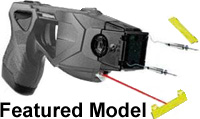
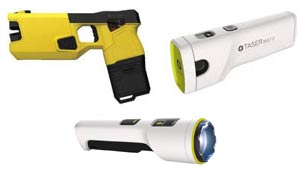

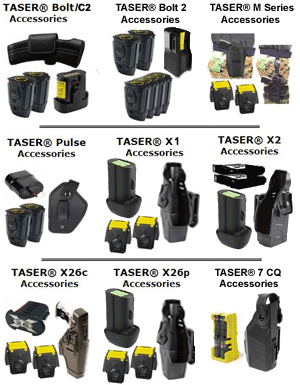
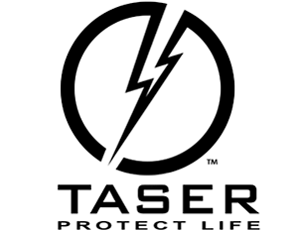
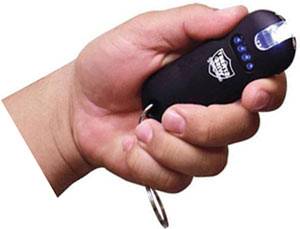
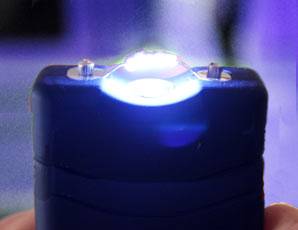
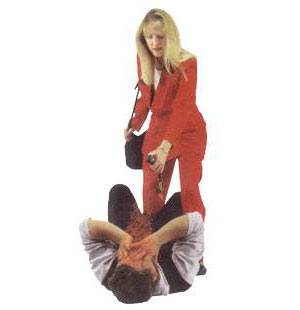




 X
X



